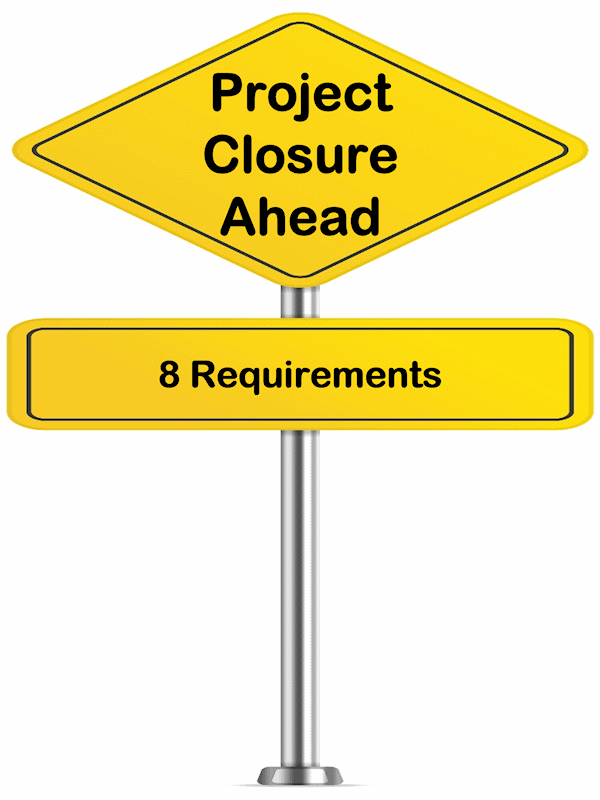By Mike Loughrin, CEO for Transformance Advisors
The Last Step – Project Closure
A project is not complete, until you work the last step – known as project closure.
During this last step, you need to:
- Tie up all loose ends
- Harvest knowledge for use in future projects
- Communicate the success to all stakeholders
- Celebrate with your team
Failure to properly close a project means you are leaving a number of small fires burning away. Don’t be a fool. These small fires will explode into raging infernos and sap your energy and reputation at the very moment you want to take on the next assignment.

“You can’t finish what you don’t start, and you should never start what you’re not committed to finish.”
– Gary Ryan Blair
Importance of Project Closure
Beyond saving your career, the other important aspects of closing a project correctly include:
- You, and your team, invested time, treasure, and talent – you want the impact to last
- You, or someone else, will build upon the success – there will always be more to come and another project springing to life
- You, and the organization, will start to forget what was done and what was learned – get it documented now, before it’s too late
- Your team has navigated the rapids of a wild river – take time to step back and reflect upon a job well done
Project closure can seem like unnecessary work. Something to avoid. It’s time to move on and let someone else tend to the small fires burning out of sight.
At the same time, the tasks for project closure are not hard and they are not difficult. Completing the tasks demonstrates you are a disciplined professional, who takes care of the details.

“We are built for novelty and excitement, not for careful attention to detail. Discipline is something we have to work at.”
– Atul Gawande, The Checklist Manifesto
Project Closure Requirements
The are 8 categories of tasks required for closing most projects.
For a small project, some tasks will be just a few minutes. For larger projects, it will take more time to ensure each area is addressed.
Project closure tasks run from the simple and obvious to opportunities for creativity. Think of these creative opportunities as a chance for you and your team to build your reputations as project management wizards.
Given the wide range of effort required for what needs to be done, project management professionals leverage the work of Atul Gawande in The Checklist Manifesto. Gawande’s recommendation is to build a checklist when there is a blend of tasks – some needing deep expertise and others which are obvious or routine. This allows you to focus on the creative needs while not missing the easy stuff.
A project closure checklist should include the following:
- Support Services
- Stakeholder Approval
- Implementation Review
- Lessons Learned
- Celebration
- Staff Transfer
- Archive
- Financial Closure
Let’s look closer at each category.

“Use a project closure template to harvest the maximum knowledge from current projects and provide future projects with lessons learned and other valuable information.”
– Mary Lewinson, Key Steps to Closing a Project
1. Support Services
Ensure resources are in place for routine on-going process and system support.
This could include:
- Ensure IT and other support people are trained and ready to quickly solve problems
- Create service level agreement for meeting support requests
- Schedule 30 day and 6 month audits to evaluate effectiveness and sustainability of changes
- Implement routine gemba walks for managers, supervisors, and other stakeholders

2. Stakeholder Approval
Verify all deliverables are complete and signed off by stakeholders.
This could include:
- Meet with stakeholders to verify they are pleased with the results
- Provide stakeholder feedback to project champion and steering committee
- Conduct focus groups with customers and suppliers
- Create video testimonials from customers and other stakeholders

3. Implementation Review
Assess actual results vs. expectations documented in the project charter.
This could include:
- Review accomplishments as they relate to the goals outlined in the project charter
- Conduct an analysis on planned vs. actual for benefits and costs
- Run a 360 assessment for all team members
- Summarize the “parking lot” items which might be great ideas, but were out of scope
- Present the implementation review to project champion and steering committee

4. Lessons Learned
Discuss and document what went right and what went wrong during the project.
This could include:
- Bring in a facilitator to guide the team in discussing the project life cycle
- Have each team member self-reflect and submit their thoughts
- Identify innovations which could transfer to other locations or departments – pay it forward
- Update relevant policies, procedures, and instructions for managing projects

5. Celebration
Celebrate with project team and other stakeholders. This is also the time to recognize key successes.
This could include:
- Schedule and plan a celebration event the whole team can attend
- Go big or go home – plan a night on the town in New Orleans and listen to Gary Brown at the Mahogany Jazz Hall
- Share key metrics on how performance has improved
- Procure and distribute customized gifts for all team members
This is not the time to seek approval for a celebration. Wise project managers got agreement for a celebration when the project charter was approved. Foolish project managers will need to get approval for an expense which was clearly known in advance!

6. Staff Transfer
Release temporary staff and reassign permanent staff.
This could include:
- Create a success story mentioning all team members and post it to social media
- Plan for everyone’s next assignment
- Complete performance reviews for all team members
- Write letters of recommendation
This is not the time to fire the people who helped improve the organization. You can fire those who refuse to change!

7. Archive
Organize all documents, including electronic, and archive them for storage and retrieval.
This could include:
- Scan documentation into electronic format
- Take photos of team members and new work areas
- Save all files on shared drive
- Move any physical items into secure storage

8. Financial Closure
Ensure all project related final invoices are paid and contracts closed out.
This could include:
- Set a deadline for completion of all financial transactions
- Ensure services with on-going monthly fees are terminated or transferred to a new project
- Transfer any physical assets to non-project related accounts
- Calculate and cut bonus checks for all team members

“Great is the art of beginning, but greater is the art of ending.”
– Henry Wadsworth Longfellow
Summary
Failure to properly close a project means you are leaving a number of small fires burning away.
These small fires will explode into raging infernos and sap your energy and reputation at the very moment you want to take on the next assignment.
Working a project closure checklist to tie up all loose ends demonstrates you are a disciplined professional – worthy of another assignment.
Use the checklist at: Template-Project-Closure

Mike Loughrin is the CEO and Founder of Transformance Advisors. He also teaches for Louisiana State University Shreveport and is on the board of directors for the Association for Supply Chain Management Northern Colorado.
Mike brings exceptional experience in industry, consulting services, and education. He has directed several Lean Transformation programs and has helped organizations such as Levi Strauss, Warner Bros., Cabela’s, Constellation Brands, Lexmark, and Sweetheart Cup.
Keeping a commitment to a balanced life, Mike loves downhill skiing, bicycle rides, and hiking in the mountains. See one of his trails of the month at: Little Switzerland.
Project Failure
Bashing Best Practices
Recommendation Reports
Dangers of Low Hanging Fruit
Team Effectiveness Assessment
Subscribe to our newsletter
References
The Checklist Manifesto by Atul Gawande
Key Steps to Closing a Project by Mary Lewinson

